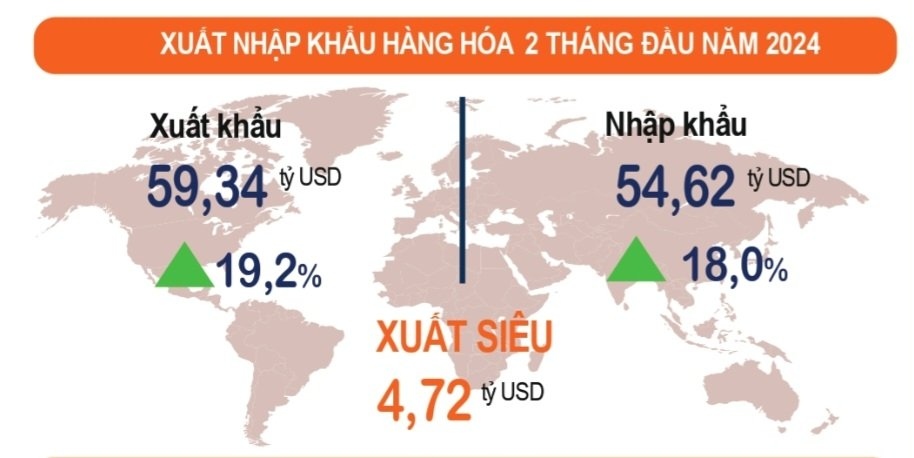Two months into this year, over 41,000 newly registered and reactivated businesses were recorded nationwide, with 63,000 businesses exiting the market. During the same period, investment capital from the state budget increased by over 2%, while FDI reached the highest level in 5 years. The total import and export turnover reached nearly $114 billion, a nearly 19% increase. The basic inflation rate was controlled at 2.84%. In more detail, VOV reporters discussed these issues with Ms. Do Thi Ngoc, Deputy Director General of the General Statistics Office:
PV: Madam, based on the data analysis, what notable points does the General Statistics Office identify in the economic activity during the first two months of this year?
Ms. Do Thi Ngoc: In the economic landscape of the first two months of this year, there are several positive highlights. Firstly, in the agricultural sector, pig and poultry farming continue to thrive, with stable consumption markets. Rice, vegetables, tubers, fruits, and aquaculture have all shown significant increases compared to the same period last year. In the industrial sector, the industrial production index for the first two months of this year increased by 5.7% compared to the same period last year, with the processing and manufacturing industry increasing by 5.9%. Some secondary industrial sectors also experienced a high growth rate. The service sector has also been lively, with total retail sales of goods and consumer service revenue increasing by 8.1% compared to the same period last year. The import and export turnover reached $113.9 billion, a 18.6% increase compared to the same period. This is a relatively high growth rate, estimating a trade surplus of $4.72 billion.
In the international tourism services sector, due to the effective visa policies and stimulation programs, as well as the efforts of the government and people, the number of international tourists increased by 68.7% to over 3 million arrivals. In terms of investment capital executed from the state budget, it increased by 2.1% and reached 8.4% compared to the annual plan. The foreign direct investment in Vietnam in the first two months also reached $2.8 billion, a 9.8% increase compared to the same period. This growth rate is the highest in the first two months of the past 5 years.

Image
Alongside the positive points, there are also some existing limitations. In the agricultural sector, the area of winter-spring crops and vegetables has decreased due to prolonged cold weather, as well as the high costs of fertilizers and raw materials. In terms of industrial production, the production index of optical computers has not increased significantly due to the lackluster global market.
Regarding the challenges in import and export, tensions in the South China Sea have increased transportation costs and affected Vietnam’s import and export activities, as well as those of European regions. In terms of business registration, during the first two months of this year, the number of businesses exiting the market was higher than the number of new businesses joining the market, with 63,000 businesses exiting compared to only 41,100 new businesses.
PV: Among these indices, which ones indicate promising developments that can support economic growth in the near future?
Ms. Do Thi Ngoc: The industrial sector has shown signs of recovery, especially in import and export activities, which have experienced strong signs of recovery. This also indicates a global market demand recovery. This is a motivation. We also noticed that in the early months of the year, businesses received many orders, and the manufacturing industry has increased to meet domestic and export demands, resulting in a 5.7% increase in the industrial production index for the first two months.

Image
Another index that we can cross-reference is the PMI index in January 2004, which also increased to 50.3%, with new export orders increasing for the first time since October 2013. When exports increase, Vietnamese products gain momentum, promoting domestic production and contributing to the growth of all three economic sectors: agriculture, industry, and services. This is the driving force for Vietnam’s economic growth in 2024.
PV: Based on these realities, what recommendations does the General Statistics Office propose for the economy in the coming time, in order to achieve annual growth?
Ms. Do Thi Ngoc: Firstly, we must continue to implement proactive and flexible monetary policies in conjunction with a reasonable expansion of fiscal policies to create a stable macro environment and encourage investment.
Secondly, we should encourage credit organizations to reduce costs, simplify loan procedures, and strive to lower interest rates to support the economy. We should also promote measures to improve access to credit for businesses and individuals. Additionally, fiscal policies should continue to support businesses and individuals, restructuring debt, reducing interest rates and service fees, and implementing preferential credit packages.

Image

Image
We should continue to review and improve legal regulations, mechanisms, and policies in order to enhance the efficiency of implementation organizations. In addition, we should accelerate public investment projects. We should capitalize on signed trade agreements, negotiate and sign new agreements, promote the promotion of Vietnamese products and images in the world market, as well as strengthen the domestic market and domestic production.
PV: Thank you!









































![[Photo Story]: Multifaceted Perspectives on the Q1-2024 Economic Landscape](https://xe.today/wp-content/uploads/2024/04/tvd-8446-100x70.jpg)